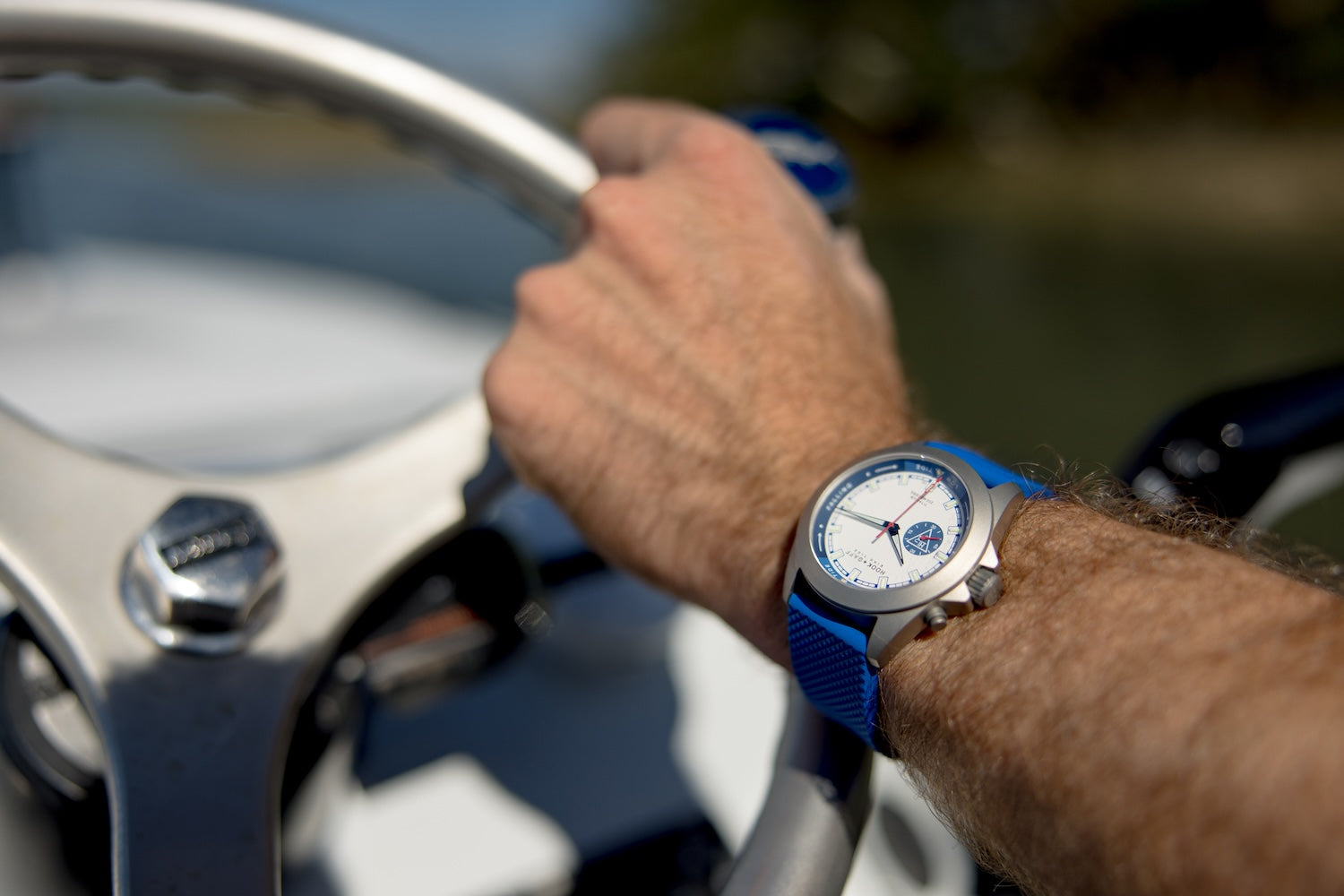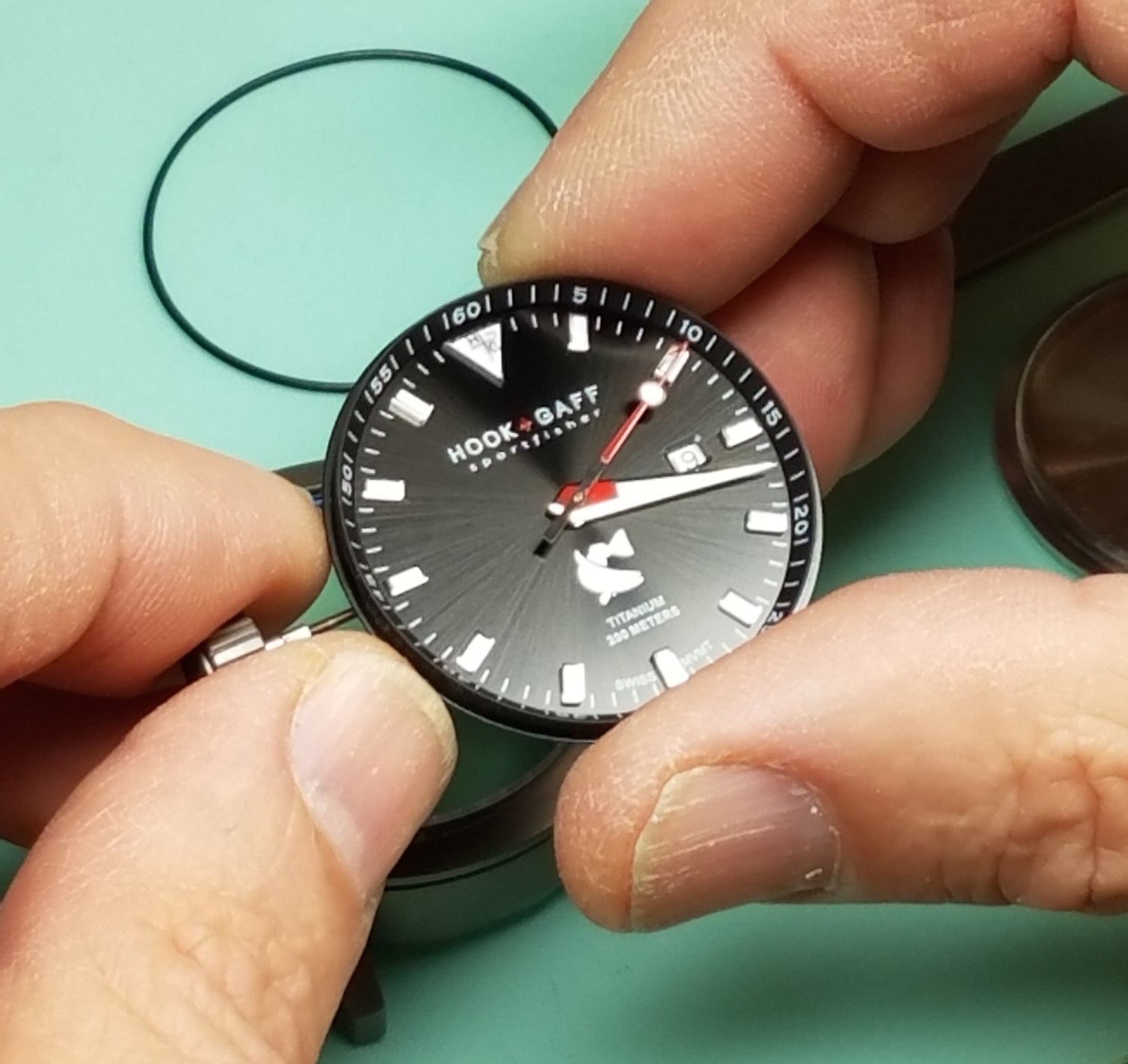All Hook+Gaff Sportfisher series watches feature custom Swiss quartz movement, but what makes that so special? Read below to find out the origins of this movement type and what makes it so popular!

What is a watch’s movement?
A watch’s “movement” refers to the part of the device that drives the hands on a watch face to make it tick. It’s often described as the heart of a watch, but perhaps brain would be more accurate — in addition to tracking the time of day, a watch’s movement powers features such as its calendar and chronograph.
How does quartz movement work?
Quartz movement watches, which account for approximately 90% of the world’s watches, use a battery as their primary power source. To generate power in quartz watch movements, the battery sends an electrical current through a small quartz crystal, which electrifies the crystal and creates subsequent vibrations about 33 times per second. These small vibrations keep the movement oscillating, which in turn drives the motor to move the watch hands.
So what makes quartz movement so popular?
Quartz movements are very accurate and reliable when it comes to the time, and they typically require minimal manual maintenance aside from battery replacements. Plus, quartz movement watches tend to be less expensive (versus mechanical movement watches) since they are battery powered and have fewer moving parts.

What is Swiss movement?
Even non-aficionados recognize that Switzerland sets the standard by which all other watches are judged. Excellence in craftsmanship and watchmaking is a large component of the Swiss national identity, and why you see product descriptions that include names like “Swiss quartz movement” or “Swiss movement.”
Interestingly, the Swiss weren’t the first to make clocks small enough to carry around — that honor belongs to the Germans. The first tiny clocks that were made to be portable were created somewhere between 1509 and 1530, with the earliest officially documented watch created in 1530 by Peter Henlein in Nuremberg, Germany. During this period, the watches were over 3 inches long — a little too big to fit in a pocket. Because the timepieces were rare and expensive, few but nobility could afford to own them.

During the 16th century, the Swiss watch industry slowly gained traction as Western European — specifically French Huguenot — refugees entered Switzerland to escape religious persecution. When they settled into Geneva, they brought their clock- and watchmaking skills with them. Fast-forward about a century, and Geneva had earned a reputation for high-quality watchmaking. By the end of the 18th century, Geneva was exporting more than 60,000 watches annually! There were many innovations during that period, including those of Abraham-Louis Perrelet, who created the “perpetual” watch in 1770 — the basis for the modern self-winding watch.
Prior to the 1970s, the Swiss watch industry had a claim on 50% of the world watch market. That is, they did until Seiko, a Japanese watch company, introduced the world’s first quartz wristwatch and called it “the Astron.”
In the years following that reveal, this technology became increasingly popular and sought-after — so popular, in fact, there was a “quartz crisis” in the Swiss watchmaking industry. Because the Swiss didn’t adapt to the changes initially, it caused economic upheaval and massive job losses — but for watch companies in Japan and the United States, it stirred a “quartz revolution.”
The quartz technology had caused upheaval in the industry, and a battle was fought over the next several decades to provide the best, thinnest and highest-value watches of the highest quality. Eventually, Switzerland was able to redeem its reputation (and the nation’s third largest export industry) in the early 1980s with a few key innovations and financial rescue packages. As quartz technology has continued to develop, solar-, light- and motion-powered watches have all entered the playing field. And still, Swiss is the standard of quality watchmakers look toward today.
Swiss vs. Japanese Movement
When it comes to Swiss vs. Japanese movement watches, there are typically two schools of thought. And generally, the battle loosely boils down to one between practicality and luxury. From a technical standpoint, there aren’t huge differences between the two, but the way in which they are crafted and what features receive the most emphasis by the watchmaker do vary.
The whole Japanese approach revolves around efficiency and functionality. These watches are built with precision and effectiveness at the forefront, with aesthetics as a more secondary thought. Of course, as they proved in the late 1970s, the Japanese watchmakers do know how to create a working product that people will buy. Their watches are not as well-known for their reliability or quality as those of their Swiss counterparts, but they are usually precise and, typically, are significantly less expensive than watches with Swiss-made movements.
While the Japanese movements can offer lower prices, the Swiss-made watches have centuries of heritage to back them up. As mentioned above, the Swiss have been creating clocks and timepieces with some semblance of the same technology since the 16th century, whereas the Japanese movement didn’t gain traction until the 20th century. Despite their relatively short time in the watchmaking space, the Japanese have found a solution for lower-priced luxury. However, Swiss-made watches are still considered to be the highest standard of quality. From the cut of the metal to the color of the mechanisms, every detail is considered by a Swiss watchmaker. Aesthetics are paramount throughout the design and construction processes, and for the most part, hand assembly is still a part of the watchmaking process — something that the Japanese almost always automate with robotics. All of the intricate décor and hours of labor affect the price of a Swiss-made movement.
Both get the job done, and both are used by watchmakers all over the world. All Hook+Gaff movements come from ETA, the largest, most highly sought-after manufacturer of movements in Switzerland and a premier example of the skills the country has to offer.
Hook+Gaff creates watches with custom Swiss quartz movement that achieve a high standard of quality and are also durable enough to stand up to your outdoor lifestyle. Peruse different dial colors and strap selections here and upgrade your timepiece today!





1 comment
Elton Pope-Lance
Interesting post. In the middle picture the crown is on the right. Is that the watchmaker’s one-of-a-kind?
Interesting post. In the middle picture the crown is on the right. Is that the watchmaker’s one-of-a-kind?